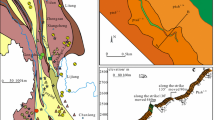Abstract
On the basis of results of the studies of primary fluid inclusions, and the hydrogen and oxygen isotope data, the authors concluded that the early-stage ore-forming fluid from the Jinchangqing gold (copper) ore deposit is a kind of sulfate type hot brine characterized by medium temperature and salinity, genetically related to the late-stage ore-forming fluid derived from an acidic and more reductive environment. However, the late-stage ore-forming fluid is a sort of low temperature and low salinity chloride-type hot brine which originated from a lower pressure, acidic and more oxidative environment. In general, the ore fluids were derived from the late-stage, or largely from the early-stage groundwater-derived meteoric water, which has a 12% – 17% heavier oxygen isotopic composition than the original rain water (δ18O = — 15. 3%), and were formed during gold mineralization as a product of oxygen isotope exchange during the reaction between ore-forming fluid and wall rocks under a lower water/rock ratio condition.
Similar content being viewed by others
References
Bodnar R. J. and Beane R. E. (1980) Temporal and spatial variations in hydrothermal fluid characteristics during vein filling in preore cover overlying deeply buried porphyry copper-type mineralization at Red Mountain, Arizona [J].Economic Geology,75, 876–893.
Brown P. E. and Lamb W. M. (1989) p-V-T properties of fluids in the system H2O ± CO2 ± NaCl: New graphical presentations and impli cations for fluid inclusion studies [J].Geochim. Cosmochim Acta,53, 1209–1221.
Campbell A., Rye D., and Petersen U. (1984) A hydrogen and oxygen isotope study of the San Cristobal mine, Peru: Implications of the role of water to rock ratio for the genesis of wolframite deposits [J].Economic Geology,79, 1818–1832.
Clayton R. N., O’Neil J. R., and Mareda T. K. (1972) Oxygen isotope exchange between quartz and water [J].Journal of Geophysical Research,77, 3057–3067.
Craig H. (1961) Isotopic variations in meteoric waters [J].Science,133, 1702–1703.
Dilles J. H., Solomon G. C., Taylor H. P. et al. (1992) Oxygen and hydrogen isotope characteristics of hydrothermal alteration at the Ann-Mason porphyry copper deposit, Yerington, Nevada [J].Economic Geology,87, 44–63.
He Mingqin, Yang Shiyu, and Liu Jiajun (2003) Organic matter in the Jinchangqing Au-Cu deposit at Xiangyun, Yunnan and its relation with gold mineralization [J].Journal of Kunming University of Science and Technology,28, 4 -7 (in Chinese with English abstract).
He Zhili (1982)Mineralogy of Inclusions [M]. pp. 1–304. Geological Publishing House, Beijing (in Chinese).
Jiang Qijie, Liu Tungshen, Chen Minyang et al. (1980) On the signifi-cance of penetrating hot brine minerogenesis and genetic indicators[J].Geology and Exploration, (1), 1–6 (in Chinese with English abstract).
Laboratory of Fluid Inclusions, Institute of Geochemistry, Chinese Academy of Sciences (1980)Inclusions in Minerals [M]. pp. 1–188. Science and Technology Press, Beijing (in Chinese).
Li Binglun, Wang Yinglan, and Xie Yihan (1982) Gas chromatographic analysis of gaseous and liquid inclusions and its geological implication [J].Scientia Geologica Sinica, (2), 220–225 (in Chinese with English abstract).
Liu Bin and Shen Kun (1999)Thermomechanics of Fluid Inclusions[M]. pp. 1–140. Geological Publishing House, Beijing (in Chinese).
Liu Jiajun, Li Chaoyang, Pan Jiayong et al. (2000) Isotope geochemistry of sandy shale-hosted copper deposits in the Lanping-Simao Basin, Yunnan [J]:Mineral Deposits,19, 223–234 (in Chinese with English abstract).
Lu Huanzhang, Li Binglun, Shen Kun et al. (1990)Geochemistry of In clusions [M]. pp. 1–242. Geological Publishing, House, Beijing (in Chinese).
Potter R. W. II, Clynne M. A., and Brown D. L. (1978) Freezing point depression of aqueous sodium chloride solutions [J].Economic Geology,73, 282–285.
Pu Chuanjie and Tang-Wanying (1998) Geological and geochemical characteristics and genesis of the Xiangyun gold deposit [J].Gold,19, 7–12 (in Chinese with English abstract).
Pu Chuanjie and Wang Lishan (1996) Modes of occurrence and techno logical characteristics of gold in the Jinchangqing gold deposit, Yunnan [J]:Geology of Yunnan,15, 62–67 (in Chinese with English abstract).
Ran Chongying (1989a)Metallogenic Mechanism of Strata-bound Copper Deposits at the Kangdian Earth’s Axis [M]. pp. 2–47. Geological Publishing House, Beijing (in Chinese).
Ran Chongying (1989b) On ore source and ore-forming fluid of Dong-chuan-Yimen type copper deposit [J].Sciences in China (Series B),32, 1117–1124.
Sawkins F. J. (1968) The significance of Na/K and C1/SO4 ratios in flu id inclusions and subsurface waters, with respect to the genesis of Mississippi valley-type ore deposits [J].Economic Geology,63, 935–942.
Sun Kexiang (1980) Hypothesis of hot brine minerogenesis [J].Geolo gy-Geochemistry, (1), 23 -37 (in Chinese with English abstract).
Taylor Jr H. P. (1974) The application of oxygen and hydrogen isotope studies to problems of hydrothermal alteration and ore deposition [J].Economic Geology,69, 843–883.
Vapnik Y. and Moroz I. (2002) Compositions and formation conditions of fluid inclusions in emerald from the Maria deposit (Mozambique) [J].Mineralogical Magazine,66, 201–213.
Wei Juying and Wang Guanyu (1988)Isotope Geochemistry [M]. pp. 1 -166. Geological Publishing House, Beijing (in Chinese).
White D. E. (1974) Diverse origins of hydrothermal ore fluids [J].Economic Geology,69, 954–973.
Yang Jiankun and Tang Zhiguo (1996) Metallogenic characteristics and ore-search prospects of Mesozoic supergenic intrusive porphyry-type gold deposits in Yunnan Province as exemplified by the Machangqing gold deposit [J].Beijing Geology, (3), 27–31 (in Chinese with English abstract).
Zhang Y. G. and Frantz J. D. (1987) Determination of the homogenization temperatures and densities of supercritical fluids in the system NaCl-KCl-CaCl2 -H2O using synthetic fluid inclusions [J].Chemical Geology,64, 335–350.
Zhang Zongxiang (1980) Several fundamental problems of the involvement of brines in minerogenesis [J].Geology and Exploration, (7), 19–21 (in Chinese with English abstract).
Author information
Authors and Affiliations
Additional information
This research project was granted jointly by the 95’ State Key Science and Technology Projects (96-914-03-04), Research Projects in 95’ Key Regions and Zones sponsored by the original Non-ferrous Metal Industry General Company (96-D-42), the State Key Basic Research, Development and Planning Program (G1999043208) and the Foundation Projects of Yunnan Provincial Education Department (0142104).
Rights and permissions
About this article
Cite this article
Mingqin, H., Huanbin, S., Jiajun, L. et al. Characteristics and origin of ore-forming fluids of Jinchangqing gold (copper) ore deposit (s) in Xiangyun, Yunnan Province. Chin. J. Geochem. 24, 136–143 (2005). https://doi.org/10.1007/BF02841156
Issue Date:
DOI: https://doi.org/10.1007/BF02841156



